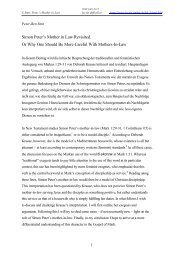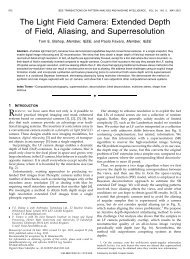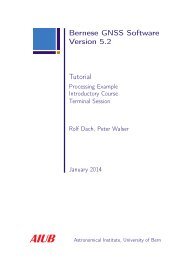Minimal Models of Adapted Neuronal Response to In Vivo–Like ...
Minimal Models of Adapted Neuronal Response to In Vivo–Like ...
Minimal Models of Adapted Neuronal Response to In Vivo–Like ...
Create successful ePaper yourself
Turn your PDF publications into a flip-book with our unique Google optimized e-Paper software.
Adapting Rate <strong>Models</strong> 2107<br />
firing rate [Hz]<br />
60<br />
40<br />
20<br />
40<br />
20<br />
0<br />
−0.6 0<br />
0 1 2<br />
0<br />
−2 0 2 4<br />
µ<br />
Figure 2: Adapting rate model from the QIF neuron, theory versus simulations.<br />
f-I curves plotted as in Figure 1A. Lines: Self-consistent solutions <strong>of</strong> equation<br />
f = QIF (µ − αf,σ), with QIF given by equation 2.4. Dots: Simulations <strong>of</strong> the<br />
full model, equations 2.1 and A.2 ( f sim ). Parameters: τ N = 500 ms, g N A N = 0.06<br />
(α = 0.03 s), τ = 20 ms, τ r = 0; σ = 0, 0.8, 1.6 (from right <strong>to</strong> left). <strong>In</strong>set: Same<br />
as in Figure 1A, for the point (µ, σ ) = (−0.2, 1.6). Mean spike frequencies f sim<br />
assessed across 50 s, after discarding a transient <strong>of</strong> 10τ N .<br />
bifurcation, where the firing rates are low. Its firing rate in the presence <strong>of</strong><br />
white noise reads<br />
QIF =<br />
[<br />
τ r + √ πτ<br />
∫ +∞<br />
−∞<br />
dx exp<br />
(−µx 2 − σ 2 x 6 )] −1<br />
, (2.4)<br />
48<br />
(see Brunel & Latham, 2003). µ and σ quantify the drift and the fluctuations<br />
<strong>of</strong> a (dimensionless) gaussian input current. The adapted response in stationary<br />
conditions is given by f = QIF (µ − αf,σ). The match between the<br />
predictions <strong>of</strong> the adapting rate model and simulations <strong>of</strong> the QIF neuron<br />
is presented in Figure 2.<br />
2.1.3 Conductance-Based IF Neuron. The scenario outlined so far considered<br />
only current-based model neurons—models in which the input current<br />
does not depend on the state <strong>of</strong> the membrane voltage. A more realistic description<br />
takes in<strong>to</strong> account the dependence <strong>of</strong> the current on the reversal<br />
potentials, V E,I , for the excita<strong>to</strong>ry and inhibi<strong>to</strong>ry inputs, respectively. The<br />
adapting rate model for this class <strong>of</strong> neurons can be derived in the same<br />
way as done for the current-based models. For the LIF neuron with reversal<br />
potentials defined in section A.3, and referred <strong>to</strong> as the conductance-based<br />
(CB) neuron in the following, one finds that the adapted response is the
















